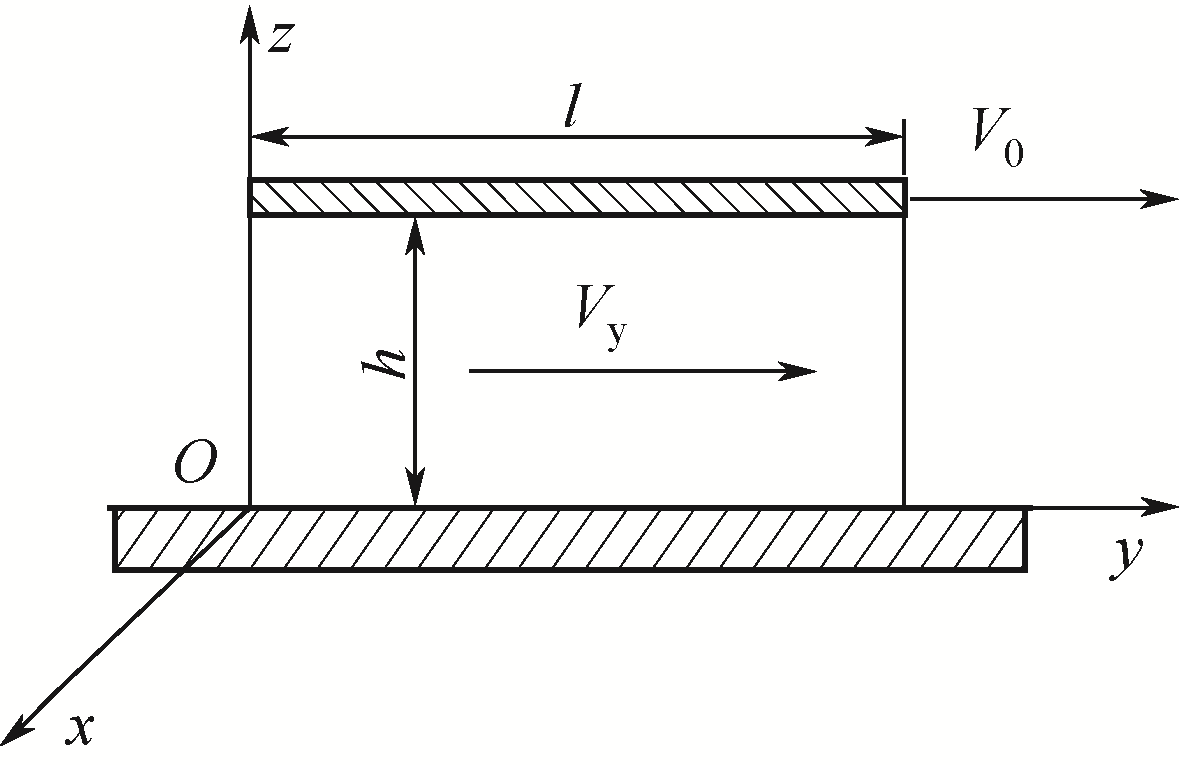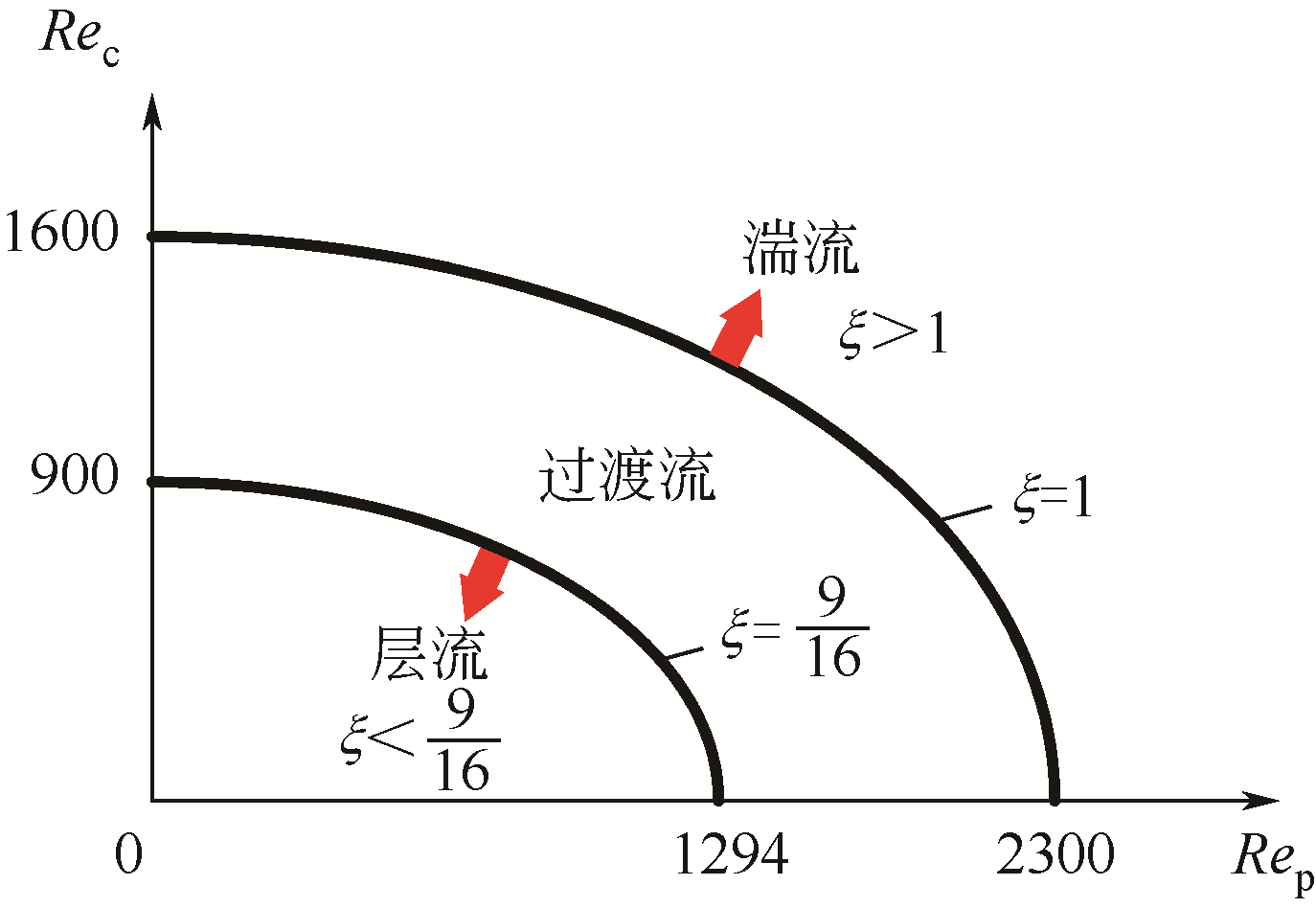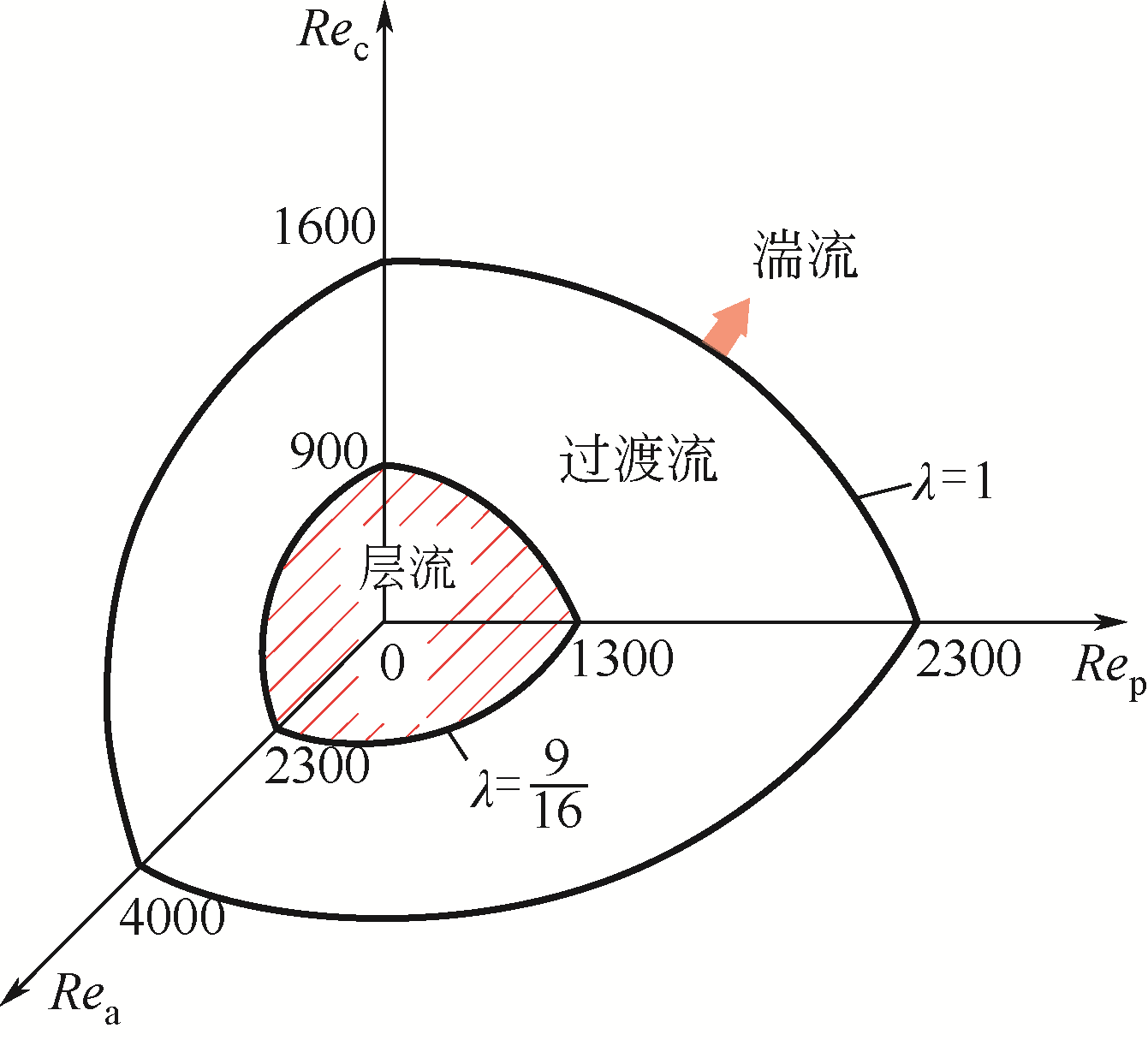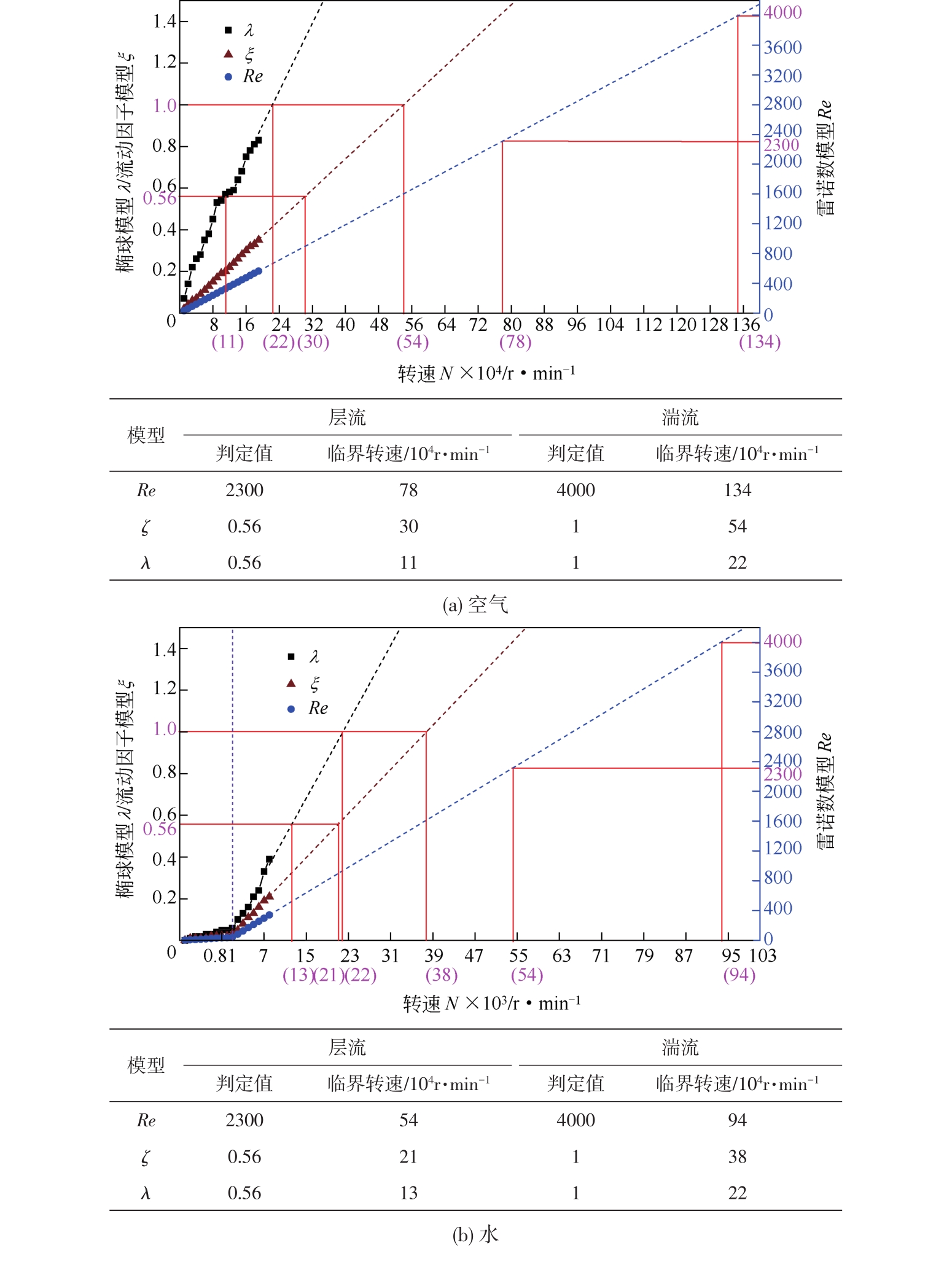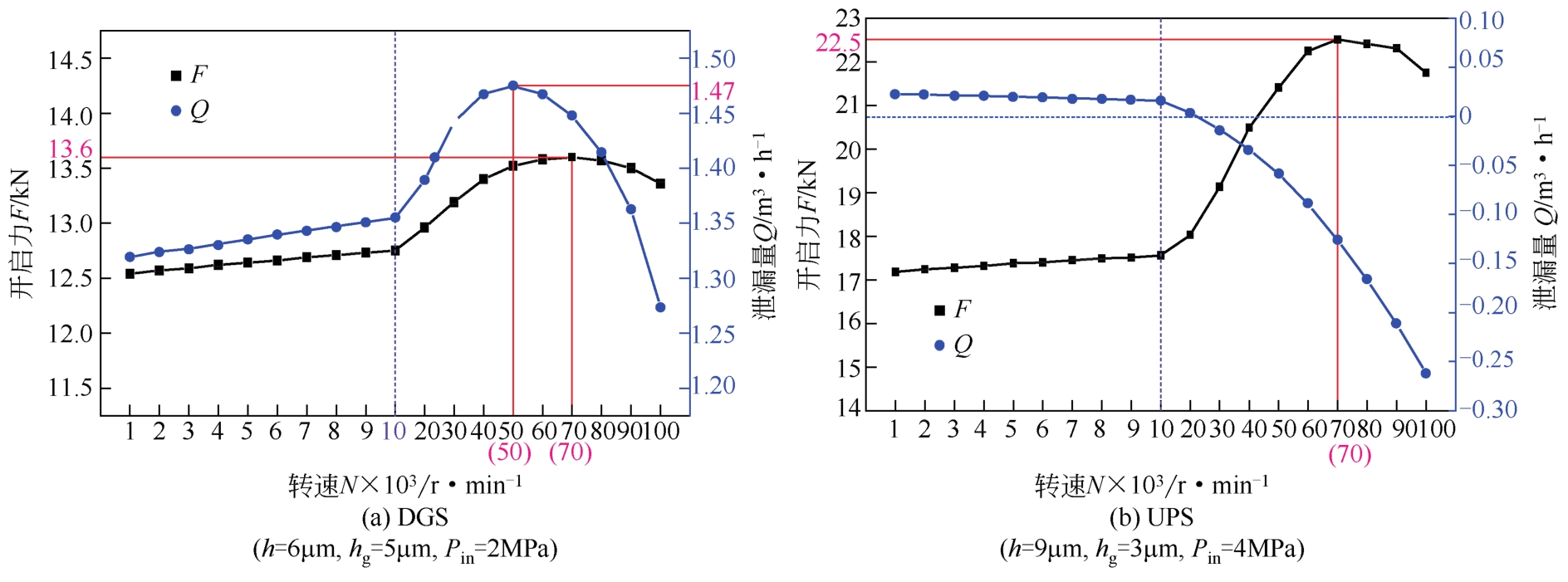化工进展 ›› 2021, Vol. 40 ›› Issue (5): 2389-2400.DOI: 10.16085/j.issn.1000-6613.2020-1257
旋转流场流态预测模型验证及其速度分量选择的差异性
王衍1( ), 曹志康1, 王英尧1, 胡琼1(
), 曹志康1, 王英尧1, 胡琼1( ), 胡鹏1, 肖业祥2
), 胡鹏1, 肖业祥2
- 1.江苏海洋大学机械工程学院,江苏 连云港 222005
2.清华大学水沙科学与水利水电工程国家重点实验室&能源与动力工程系,北京 100084
-
收稿日期:2020-08-08出版日期:2021-05-06发布日期:2021-05-24 -
通讯作者:胡琼 -
作者简介:王衍(1989—),男,博士,副教授,研究方向为流体机械与密封技术。E-mail:qqwangyan2006@163.com 。 -
基金资助:国家自然科学基金(51805199);国家重点研发计划(2017YFC0404200);江苏省自然科学基金(BK20191471);江苏省高校“青蓝工程”;江苏“六大人才高峰”项目(GDZB-076);江苏省高等学校自然科学研究面上项目(19KJB460010);江苏海洋大学人才引进科研基金(KQ19004);2020年江苏省研究生科研与实践创新计划(KYCX20-2910)
Validation of flow regime prediction model and differences of velocity component selection for rotating flow field
WANG Yan1( ), CAO Zhikang1, WANG Yingyao1, HU Qiong1(
), CAO Zhikang1, WANG Yingyao1, HU Qiong1( ), HU Peng1, XIAO Yexiang2
), HU Peng1, XIAO Yexiang2
- 1.School of Mechanical Engineering, Jiangsu Ocean University, Lianyungang 222005, Jiangsu, China
2.State Key Laboratory of Hydroscience and Engineering & Department of Energy and Power Engineering, Tsinghua University, Beijing 100084, China
-
Received:2020-08-08Online:2021-05-06Published:2021-05-24 -
Contact:HU Qiong
摘要:
鉴于目前高速旋流场中的流体流态判定准则不统一、预测模型契合度不高的问题,依据流体力学基本原理及管道、缝隙流场的判定方法,本文对经典一维雷诺数及二维流量因子预测模型进行了理论重构,并尝试提出了适用于旋转流场中流体流态判定和预测的椭球模型。文章首先根据经典雷诺数模型和流动因子模型,对仿真计算和椭球模型进行了理论验证;然后对不同介质和工况参数下的速度场进行了分析计算,并与相关文献进行对比研究;最后结合对旋转流场中拐点的理论剖析,对椭球模型的合理性和科学性进行了论证,并对模型中速度分量的选择及差异性进行了讨论。结果表明:椭球模型对管道流动的预测结果与经典雷诺数模型完全一致,新模型对旋转流场中转折点的预测值较传统模型明显偏低,与实际工况更加贴近;根据椭球模型进行旋转流场的流态判定时,应选择平均直径处的线速度为剪切平均速度、进出口径向速度平均值为径向平均速度及最大轴向速度为模型输入因子。椭球模型的提出,为旋转流场在理论计算时如何科学判定流体流态提供了新的思路和判定方法。
中图分类号:
引用本文
王衍, 曹志康, 王英尧, 胡琼, 胡鹏, 肖业祥. 旋转流场流态预测模型验证及其速度分量选择的差异性[J]. 化工进展, 2021, 40(5): 2389-2400.
WANG Yan, CAO Zhikang, WANG Yingyao, HU Qiong, HU Peng, XIAO Yexiang. Validation of flow regime prediction model and differences of velocity component selection for rotating flow field[J]. Chemical Industry and Engineering Progress, 2021, 40(5): 2389-2400.
| 管长l/mm | 管径d/mm | 介质 | 密度/kg·m-3 | 黏度/Pa·s |
|---|---|---|---|---|
| 800 | 20 | 水 | 1000 | 0.001 |
| 空气 | 1.29 | 1.86×10-5 | ||
 | ||||
表2 管流模型验证的相关参数
| 管长l/mm | 管径d/mm | 介质 | 密度/kg·m-3 | 黏度/Pa·s |
|---|---|---|---|---|
| 800 | 20 | 水 | 1000 | 0.001 |
| 空气 | 1.29 | 1.86×10-5 | ||
 | ||||
| Re | λ | 说明 | |||
|---|---|---|---|---|---|
| 0.0014 | 0.0024 | 50 | 1000 | 0.25 | Rea<2300,层流区 |
| 0.0018 | 0.0037 | 60 | 1200 | 0.30 | |
| 0.0022 | 0.0051 | 70 | 1400 | 0.35 | |
| 0.0027 | 0.0067 | 80 | 1600 | 0.40 | |
| 0.0031 | 0.0082 | 90 | 1800 | 0.45 | |
| 0.0035 | 0.0098 | 100 | 2000 | 0.50 | |
| 0.0040 | 0.0115 | 110 | 2200 | 0.55 | |
| 0.0044 | 0.0131 | 120 | 2400 | 0.60 | 2300≤Rea≤4000 过渡区 |
| 0.0047 | 0.0147 | 130 | 2600 | 0.65 | |
| 0.0050 | 0.0164 | 140 | 2800 | 0.70 | |
| 0.0054 | 0.0180 | 150 | 3000 | 0.75 | |
| 0.0057 | 0.0197 | 160 | 3200 | 0.80 | |
| 0.0059 | 0.0213 | 170 | 3400 | 0.85 | |
| 0.0062 | 0.0229 | 180 | 3600 | 0.90 | |
| 0.0065 | 0.0245 | 190 | 3800 | 0.95 | |
| 0.0067 | 0.0261 | 200 | 4000 | 1.00 | |
| 0.0069 | 0.0277 | 210 | 4200 | 1.05 | Rea>4000湍流区 |
| 0.0072 | 0.0293 | 220 | 4400 | 1.10 | |
| 0.0074 | 0.0309 | 230 | 4600 | 1.15 |
表3 管流中三类模型判定值对比(水)
| Re | λ | 说明 | |||
|---|---|---|---|---|---|
| 0.0014 | 0.0024 | 50 | 1000 | 0.25 | Rea<2300,层流区 |
| 0.0018 | 0.0037 | 60 | 1200 | 0.30 | |
| 0.0022 | 0.0051 | 70 | 1400 | 0.35 | |
| 0.0027 | 0.0067 | 80 | 1600 | 0.40 | |
| 0.0031 | 0.0082 | 90 | 1800 | 0.45 | |
| 0.0035 | 0.0098 | 100 | 2000 | 0.50 | |
| 0.0040 | 0.0115 | 110 | 2200 | 0.55 | |
| 0.0044 | 0.0131 | 120 | 2400 | 0.60 | 2300≤Rea≤4000 过渡区 |
| 0.0047 | 0.0147 | 130 | 2600 | 0.65 | |
| 0.0050 | 0.0164 | 140 | 2800 | 0.70 | |
| 0.0054 | 0.0180 | 150 | 3000 | 0.75 | |
| 0.0057 | 0.0197 | 160 | 3200 | 0.80 | |
| 0.0059 | 0.0213 | 170 | 3400 | 0.85 | |
| 0.0062 | 0.0229 | 180 | 3600 | 0.90 | |
| 0.0065 | 0.0245 | 190 | 3800 | 0.95 | |
| 0.0067 | 0.0261 | 200 | 4000 | 1.00 | |
| 0.0069 | 0.0277 | 210 | 4200 | 1.05 | Rea>4000湍流区 |
| 0.0072 | 0.0293 | 220 | 4400 | 1.10 | |
| 0.0074 | 0.0309 | 230 | 4600 | 1.15 |
| Re | λ | 说明 | |||
|---|---|---|---|---|---|
| 0.0189 | 0.1360 | 700 | 970.97 | 0.24 | Rea<2300, 层流区 |
| 0.0275 | 0.1067 | 900 | 1248.39 | 0.31 | |
| 0.0363 | 0.2875 | 1100 | 1525.81 | 0.38 | |
| 0.0449 | 0.2299 | 1300 | 1803.23 | 0.45 | |
| 0.0534 | 0.2814 | 1500 | 2080.65 | 0.52 | |
| 0.0616 | 0.4879 | 1700 | 2358.06 | 0.59 | 2300≤Rea≤4000 过渡区 |
| 0.0687 | 0.5708 | 1900 | 2635.48 | 0.66 | |
| 0.0755 | 0.3491 | 2100 | 2912.90 | 0.73 | |
| 0.0815 | 0.3629 | 2300 | 3190.32 | 0.80 | |
| 0.0871 | 0.4347 | 2500 | 3467.74 | 0.87 | |
| 0.0923 | 0.5172 | 2700 | 3745.16 | 0.94 | |
| 0.0972 | 0.6076 | 2900 | 4022.58 | 1.01 | Rea>4000 湍流区 |
| 0.1018 | 0.7070 | 3100 | 4300.00 | 1.08 | |
| 0.1063 | 0.8353 | 3300 | 4577.42 | 1.14 | |
| 0.1105 | 0.9367 | 3500 | 4854.84 | 1.21 | |
| 0.1147 | 1.0440 | 3700 | 5132.26 | 1.28 | |
| 0.1190 | 1.1777 | 3900 | 5409.68 | 1.35 |
表4 管流中三类模型判定值对比(空气)
| Re | λ | 说明 | |||
|---|---|---|---|---|---|
| 0.0189 | 0.1360 | 700 | 970.97 | 0.24 | Rea<2300, 层流区 |
| 0.0275 | 0.1067 | 900 | 1248.39 | 0.31 | |
| 0.0363 | 0.2875 | 1100 | 1525.81 | 0.38 | |
| 0.0449 | 0.2299 | 1300 | 1803.23 | 0.45 | |
| 0.0534 | 0.2814 | 1500 | 2080.65 | 0.52 | |
| 0.0616 | 0.4879 | 1700 | 2358.06 | 0.59 | 2300≤Rea≤4000 过渡区 |
| 0.0687 | 0.5708 | 1900 | 2635.48 | 0.66 | |
| 0.0755 | 0.3491 | 2100 | 2912.90 | 0.73 | |
| 0.0815 | 0.3629 | 2300 | 3190.32 | 0.80 | |
| 0.0871 | 0.4347 | 2500 | 3467.74 | 0.87 | |
| 0.0923 | 0.5172 | 2700 | 3745.16 | 0.94 | |
| 0.0972 | 0.6076 | 2900 | 4022.58 | 1.01 | Rea>4000 湍流区 |
| 0.1018 | 0.7070 | 3100 | 4300.00 | 1.08 | |
| 0.1063 | 0.8353 | 3300 | 4577.42 | 1.14 | |
| 0.1105 | 0.9367 | 3500 | 4854.84 | 1.21 | |
| 0.1147 | 1.0440 | 3700 | 5132.26 | 1.28 | |
| 0.1190 | 1.1777 | 3900 | 5409.68 | 1.35 |
外径ro /mm | 内径ri /mm | 膜厚h /μm | 介质压力 /MPa | 环境压力 /MPa | 介质 | 密度 /kg·m-3 | 黏度 /Pa·s |
|---|---|---|---|---|---|---|---|
| 77.78 | 58.42 | 3 | 0.5 | 0.103 | 水 | 1000 | 0.001 |
| 空气 | 1.29 | 1.86×10-5 | |||||
 | |||||||
表5 旋转流模型验证相关参数
外径ro /mm | 内径ri /mm | 膜厚h /μm | 介质压力 /MPa | 环境压力 /MPa | 介质 | 密度 /kg·m-3 | 黏度 /Pa·s |
|---|---|---|---|---|---|---|---|
| 77.78 | 58.42 | 3 | 0.5 | 0.103 | 水 | 1000 | 0.001 |
| 空气 | 1.29 | 1.86×10-5 | |||||
 | |||||||
外径ro /mm | 内径ri /mm | 槽深hg /mm | 膜厚h /mm | 介质 压力po /MPa | 环境 压力pi /MPa | 转速N /r·min-1 | 介质 | 密度 /kg·m-3 | 黏度 /Pa·s |
|---|---|---|---|---|---|---|---|---|---|
| 77.78 | 58.42 | 3 | 9 | 4 | 0.103 | 0~5000 | 水 | 1000 | 0.001 |
 | |||||||||
表6 上游泵送机械密封相关参数
外径ro /mm | 内径ri /mm | 槽深hg /mm | 膜厚h /mm | 介质 压力po /MPa | 环境 压力pi /MPa | 转速N /r·min-1 | 介质 | 密度 /kg·m-3 | 黏度 /Pa·s |
|---|---|---|---|---|---|---|---|---|---|
| 77.78 | 58.42 | 3 | 9 | 4 | 0.103 | 0~5000 | 水 | 1000 | 0.001 |
 | |||||||||
外径ro /mm | 内径ri /mm | 槽深hg /μm | 膜厚h /μm | 介质 压力po /MPa | 环境 压力pi /MPa | 转速N /r·min-1 | 介质 | 密度 /kg·m-3 | 黏度 /Pa·s |
|---|---|---|---|---|---|---|---|---|---|
| 77.78 | 58.42 | 5 | 5 | 1 | 0.103 | 1×103~1×105 | 空气 | 1.29 | 1.86×10-5 |
 | |||||||||
表7 干气密封相关参数
外径ro /mm | 内径ri /mm | 槽深hg /μm | 膜厚h /μm | 介质 压力po /MPa | 环境 压力pi /MPa | 转速N /r·min-1 | 介质 | 密度 /kg·m-3 | 黏度 /Pa·s |
|---|---|---|---|---|---|---|---|---|---|
| 77.78 | 58.42 | 5 | 5 | 1 | 0.103 | 1×103~1×105 | 空气 | 1.29 | 1.86×10-5 |
 | |||||||||
| 模型 | 上游泵送临界转速/103r·min-1 | 干气密封临界转速/104r·min-1 | ||
|---|---|---|---|---|
| 层流 | 湍流 | 层流 | 湍流 | |
| Re | 18 | 31 | 39 | 67 |
| ξ | 7 | 13 | 15 | 27 |
| λ | — | — | 0.5 | 0.8 |
表8 对应工况下的模型判定结果
| 模型 | 上游泵送临界转速/103r·min-1 | 干气密封临界转速/104r·min-1 | ||
|---|---|---|---|---|
| 层流 | 湍流 | 层流 | 湍流 | |
| Re | 18 | 31 | 39 | 67 |
| ξ | 7 | 13 | 15 | 27 |
| λ | — | — | 0.5 | 0.8 |
| 1 | BRUNETIERE N, TOURNERIE B, FRENE J. Influence of fluid flow regime on performances of non-contacting liquid face seals[J]. Journal of Tribology, 2002, 124(3): 515-523. |
| 2 | 丁雪兴, 富影杰, 张静, 等. 基于CFD的螺旋槽干气密封端面流场流态分析[J]. 排灌机械工程学报, 2010, 28(4): 330-334. |
| DING Xuexing, FU Yingjie, ZHANG Jing, et al. Fluid state analysis on flow field of gas seal with spiral groove based on CFD[J]. Journal of Drainage and Irrigation Machinery Engineering, 2010, 28(4): 330-334. | |
| 3 | 陈汇龙, 王强, 李雯瑜, 等. 基于Fluent的螺旋槽上游泵送机械密封三维微间隙流场数值模拟[J]. 润滑与密封, 2012, 37(2): 16-18. |
| CHEN Huilong, WANG Qiang, LI Wenyu, et al. Numerical simulation of 3-D flow in upstream pumping mechanical seals with spiral grooves based on Fluent[J]. Lubrication Engineering, 2012, 37(2): 16-18. | |
| 4 | XU J, PENG X D, BAI S X, et al. CFD simulation of microscale flow field in spiral groove dry gas seal[C]//Proceedings of the Mechatronics and Embedded Systems and Applications IEEE/ASME International Conference, Suzhou, 2012. |
| 5 | FAIRUZ Z M, JAHN I. The influence of real gas effects on the performance of supercritical CO2 dry gas seals[J]. Tribology International, 2016, 102: 333-347. |
| 6 | MAYER E. 机械密封[M]. 6版. 北京: 化学工业出版社, 1981: 170-173. |
| MAYER E. Mechanical seal[M]. 6th ed. Beijing: Chemical Industry Press, 1981: 170-173. | |
| 7 | 马纲, 赵伟, 沈心敏. 螺旋槽气膜密封微间隙流场的三维数值模拟[J]. 润滑与密封, 2012, 37(3): 7-11. |
| MA Gang, ZHAO Wei, SHEN Xinmin. Three dimensional numerical simulation of micro-gap flow field in spiral groove membrane seal[J]. Lubrication Engineering, 2012, 37(3): 7-11. | |
| 8 | YASUNA J A, HUGHES W F. Squeeze film dynamics of two-phase seals: part Ⅱ—turbulent flow[J]. Journal of Tribology, 1994, 114(3): 479-488. |
| 9 | RANSOM D L, ANDRES L S. Identification of force coefficients from a gas annular seal-effect of transition flow regime to turbulence[J]. Tribology Transactions, 1999, 42 (3): 487-494. |
| 10 | SHAHIN I, GADALA M, ALQARADAWI M, et al. Three dimensional computational study for spiral dry gas seal with constant groove depth and different tapered grooves[J]. Procedia Engineering, 2013, 68(12): 205-212. |
| 11 | SUN J J, MA C B, YU Q P, et al. Numerical analysis on a new pump-out hydrodynamic mechanical seal[J]. Tribology International, 2017, 106: 62-70. |
| 12 | JIANG J B, PENG X D, LI J Y, et al. A comparative study on the performance of typical types of bionic groove dry gas seal based on bird wing[J]. Journal of Bionic Engineering, 2016, 13(2): 324-334. |
| 13 | WANG Y M, YANG H X, WANG J L, et al. Theoretical analyses and field applications of gas-film lubricated mechanical face seals with herringbone spiral grooves[J]. Tribology Transactions, 2009, 52(6): 800-806. |
| 14 | SU H, RAHMANI R, RAHNEJAT H. Thermohydrodynamics of bidirectional groove dry gas seals with slip flow[J]. International Journal of Thermal Sciences, 2016, 110: 270-284. |
| 15 | WANG B, ZHANG H Q, CAO H J. Flow dynamics of a spiral-groove dry-gas seal[J]. Chinese Journal of Mechanical Engineering, 2013, 26(1): 78-84. |
| 16 | 丁雪兴, 张鹏高, 黄义仿, 等. 螺旋槽干气密封微间隙流场的CFD数值模拟[J]. 化工机械, 2008, 36(5): 287-290. |
| DING Xuexing, ZHANG Penggao, HUANG Yifang, et al. Numerical simulation of computational fluid dynamics(CFD) of the micro-scale flow field in the spiral groove dry gas seals[J]. Chemical Engineering & Machinery, 2008, 36(5): 287-290. | |
| 17 | FELDMAN Y, KLIGERMAN Y, ETSION I, et al. The validity of the reynolds equation in modeling hydrostatic effects in gas lubricated textured parallel surfaces[J]. Journal of Tribology, 2006, 128(2): 345-350. |
| 18 | 张鸣远. 高等工程流体力学[M]. 北京: 高等教育出版社, 2012: 324-325. |
| ZHANG Mingyuan. Advanced engineering fluid mechanics[M]. Beijing: Higher Education Press, 2012: 324-325. | |
| 19 | 张兆顺. 流体力学[M]. 3版. 北京: 清华大学出版社, 2015: 317-319. |
| ZHANG Zhaoshun. Fluid mechanics[M]. 3rd ed. Beijing: Tsinghua University Press, 2015: 317-319. | |
| 20 | 陈卓如. 工程流体力学[M]. 3版. 北京: 高等教育出版社, 2013: 248-259. |
| CHEN Zhuoru. Engineering fluid mechanics[M]. 3rd ed. Beijing: Higher Education Press, 2013: 248-259. | |
| 21 | 杜建军, 刘暾, 张国庆, 等. 带有圆周方向均压槽的静压气体止推轴承的气锤自激[J]. 润滑与密封, 2010, 35(1): 9-12. |
| DU Jianjun, LIU Tun, ZHANG Guoqing, et al. Study of self-excited vibration for externally pressurized gas thrust bearing with circumferential groove[J]. Lubrication Engineering, 2010, 35(1): 9-12. | |
| 22 | 叶燚玺. 超精密运动平台中气浮支承振动特性的研究[D]. 武汉: 华中科技大学, 2010. |
| YE Yixi. Vibration characteristics of ultra precision motion platform in the floating support[D]. Wuhan: Huazhong University of Science and Technology, 2010. | |
| 23 | 张鸣, 朱煜, 段广洪. 超精密气浮工件台的微振动及其抑制[J]. 制造技术与机床, 2005(11): 47-49. |
| ZHANG Ming, ZHU Yu, DUAN Guanghong. Micro-vibration of ultra-precision gas bearing linear motion stage and its elimination[J]. Manufacturing Technology & Machine Tool, 2005(11): 47-49. | |
| 24 | CHEN X D, HE X M. The effect of the recess shape on performance analysis of the gas-lubricated bearing in optical lithography[J]. Tribology International, 2006, 39(11): 1336-1341. |
| 25 | 王衍, 葛云路, 黄国庆, 等. 干气密封旋转流场的宏观特性与介观速度场的逻辑关系研究[J].摩擦学学报, 2020, 40(3): 377-390. |
| WANG Yan, GE Yunlu, HUANG Guoqing, et al. Study on the logic relationship between macroscopic characteristics and mesoscopic velocity field of high-speed rotating flow field of dry gas seal[J]. Tribology, 2020, 40(3): 377-390. | |
| 26 | WANG Y, GE Y L, HUANG G Q, et al. Microscale flow field analysis and flow prediction model exploration of dry gas seal[J]. IEEE Access, 2020, 8: 52663-52675. |
| 27 | 王衍, 胡琼, 肖业祥, 等. 超高速干气密封扰流效应及抑扰机制[J]. 航空学报, 2019, 40(10): 116-125. |
| WANG Yan, HU Qiong, XIAO Yexiang, et al. Turbulence effect and suppression mechanism of dry gas seal at ultra-high speeds[J]. Acta Aeronautica et Astronautica Sinica, 2019, 40(10): 116-125. | |
| 28 | 江锦波. 高速干气密封端面型槽仿生设计理论与实验研究[D]. 杭州:浙江工业大学, 2016. |
| JIANG Jinbo. Theoretical and experimental study of the bionic design of grooved surface of a high speed dry gas seal[D]. Hangzhou: Zhejiang University of Technology, 2016. | |
| 29 | 王衍, 孙见君, 陶凯, 等. T型槽气膜密封数值分析及槽型优化[J]. 摩擦学学报, 2014, 34(4):420-427. |
| WANG Yan, SUN Jianjun, TAO Kai, et al. Numerical analysis of T-groove dry gas seal and groove optimization[J]. Tribology, 2014, 34(4): 420-427. |
| [1] | 章凯, 金捍宇, 刘思宇, 王帅. 鼓泡流态化气泡间相互作用下相间传质过程的模拟[J]. 化工进展, 2023, 42(6): 2828-2835. |
| [2] | 金涌, 程易, 白丁荣, 张晨曦, 魏飞. 中国流态化技术研发史略[J]. 化工进展, 2023, 42(6): 2761-2780. |
| [3] | 袁守正, 陈啸, 蒋鸣, 余亚雄, 周强. 气固下行床中壁面对介尺度曳力的影响规律[J]. 化工进展, 2023, 42(5): 2272-2281. |
| [4] | 尹少武, 张朝, 康鹏, 韩嘉维, 王立. 硅粉氮化输送床内气固反应过程数值模拟[J]. 化工进展, 2022, 41(5): 2256-2267. |
| [5] | 彭威, 刘艳升, 韩胜贤, 黄炳庆. 影响FCC再生立管输送催化剂影响因素的分析[J]. 化工进展, 2020, 39(8): 2947-2953. |
| [6] | 张晨曦, 蔡达理, 贾瞾, 崔宇, 王垚, 罗国华, 骞伟中, 魏飞. 流化床中气固均匀分布的失稳现象[J]. 化工进展, 2019, 38(01): 155-170. |
| [7] | 屠功毅, 宗弘元, 钟思青, 徐俊, 周靖, 辛忠. 流化床内粉煤气固流动特性的实验研究[J]. 化工进展, 2017, 36(S1): 180-186. |
| [8] | 王玲, 郑燕萍, 程榕, 杨阿三, 孙勤, 张许力. FeCl2·4H2O晶体流态化煅烧过程实验研究[J]. 化工进展, 2017, 36(09): 3189-3194. |
| [9] | 李绪宾, 刘会娥, 陈爽, 王玉斌, 穆国庆, 刘进玲. 工业废盐的流态化行为[J]. 化工进展, 2017, 36(01): 81-90. |
| [10] | 黄成, 吴昊凡, 黄河源, 夏立, 孙宁, 李学来. 螺旋刮削式流态冰制取性能的实验研究[J]. 化工进展, 2017, 36(01): 59-65. |
| [11] | 闫岩, 卢旭晨, 王体壮, 张志敏. 利用老卤生产高纯氧化镁技术研究进展[J]. 化工进展, 2016, 35(10): 3251-3257. |
| [12] | 张攀, 段继海, 王伟文, 陈光辉, 李建隆. 基于充分混合、均匀分布准则的化工过程强化:青岛科技大学的实践[J]. 化工进展, 2016, 35(10): 3016-3021. |
| [13] | 王勇, 杨启容, 吴荣华, 陈霄. 污水换热器流态化在线防、除垢实验[J]. 化工进展, 2015, 34(12): 4398-4402. |
| [14] | 陶中东,顾正东,吴东方. 颗粒流化磨损研究进展[J]. 化工进展, 2014, 33(10): 2535-2539. |
| [15] | 李娜,王嘉骏,冯连芳,顾雪萍. 黏结性粗颗粒流动与流态化的研究进展[J]. 化工进展, 2014, 33(02): 298-303. |
| 阅读次数 | ||||||
|
全文 |
|
|||||
|
摘要 |
|
|||||

